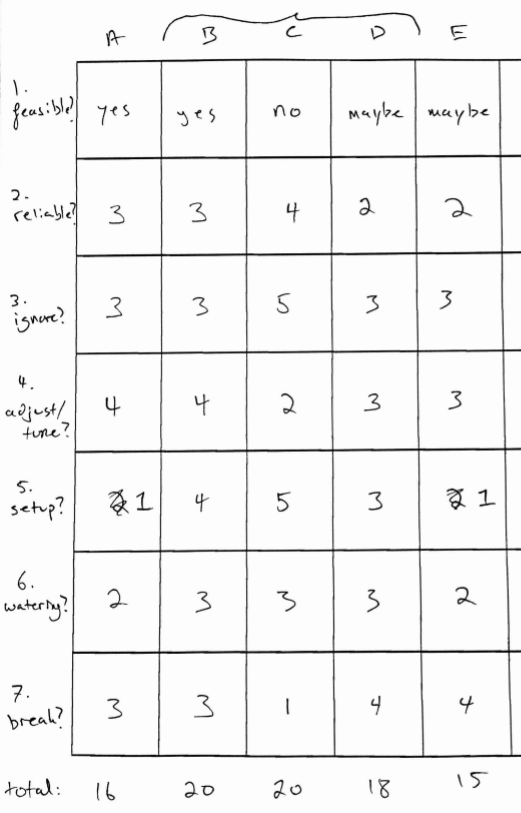Product Design
Process Drives Product Design Creativity, Part 2
In product design, brainstorming is too often a process that lacks all structure, and thus consistently generates mediocre solutions to a poorly defined problem. Brainstorming is useless without structure! Using the methods I’ll describe here, you can generate creative solutions for any product design challenge. Let’s continue with the design of a better tabletop planter. In Part 1 we defined the problem. If you haven’t read Part 1, go do it now. Our challenge is to:
Design an indoor planter that assists the user in maintaining optimal moisture content.
Then we spent time identifying and developing problem constraints, requirements, and objectives. We also took a close look at all of the variables and components of a planter system. Which variables have the most effect on soil moisture? Now we know, and we know exactly what we want our design to do. These are our design objectives.
Now that we understand the problem it’s time to generate creative solutions. I’ll show you the process I use to “brainstorm” awesome things: the morphological method.
This is about following a process in order to generate innovative solutions. Every corner cut along the way is a missed opportunity to generate a unique solution.
We know what we want the design to do, but we don’t know how to do it. That’s actually exactly where we want to be! What will determine whether or not we meet the design objectives? How can we ensure that the user is happy with the product? The answer is simple: the function of the product. But what is the primary, overarching function of this product?
Primary Function
What is the function of the product we are designing? Don’t try to jump ahead to the answer here, even though it may appear straightforward. This is about following a process in order to generate an innovative solution. Every corner cut along the way is a missed opportunity to generate a unique solution. Back to it: we need to name the function; the primary, overarching function; the single function that captures what this thing does. Follow these steps:
- Identify the system and its inputs, outputs, and interfaces. Include all exchanges of energy, matter, force, and information.
- How will the customer know if the product works?
- Now identify the overall primary function.
By “identify the system” I mean to map out and understand thoroughly the system in which our product operates and any systems within our product. Make a sketch with all of the interacting elements; all of the exchanges of matter, energy, force, or information; and you’ve got it. Here’s mine.
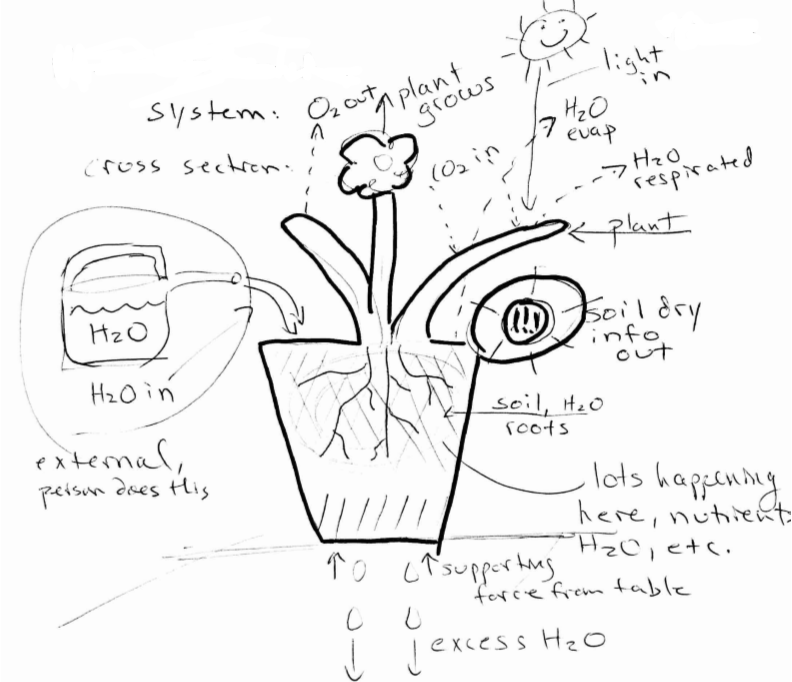
From this diagram, we can identify our inputs, outputs, and interfaces.
Inputs include: water, CO2, light, and the supporting force from the table
Outputs include: water (liquid and vapor), O2, and information regarding dryness
Interfaces are: between table and planter, between planter and soil, between soil and air, between plant and air (leaves), between plant and soil
With the system identified, we now ask ourselves: how will our customer know that the product works? Well…it will work if the plant doesn’t die. The user will know if the design works by whether or not the plant thrives.
<<Begin primary function generation>>
We must design the system shown above such that the plant thrives.
The system’s function is to support plant growth.
Contain soil and root zone.
Physically support the plant and allow exchange of water.
Physically support root system and maintain acceptable conditions for growth.
Physically support root system and exchange liquid water at optimal rates for plant health.
I think I got it…
The primary function of this planter is to physically support the plant’s root system and exchange liquid water at an optimal rate.
We can break this into two primary functions (it’s OK to have two).
-
Physically support plant root system
-
Exchange water at optimal rate
That’s it, we have two primary functions! Now we need concepts that perform these functions. To do that, first, we will break the functions into the simplest sub-functions possible. This process is called functional decomposition. From our sub-functions we will select a few critical sub-functions and use them to drive concept generation.
Functional Decomposition
Functional decomposition is an iterative process, so don’t worry about getting it just right the first time. If you find that you have other functions you want your product to serve, but they don’t fall under the primary function, list them separately as secondary functions. Here’s my first functional decomposition. After this I went digital.

And after five iterations, my final.
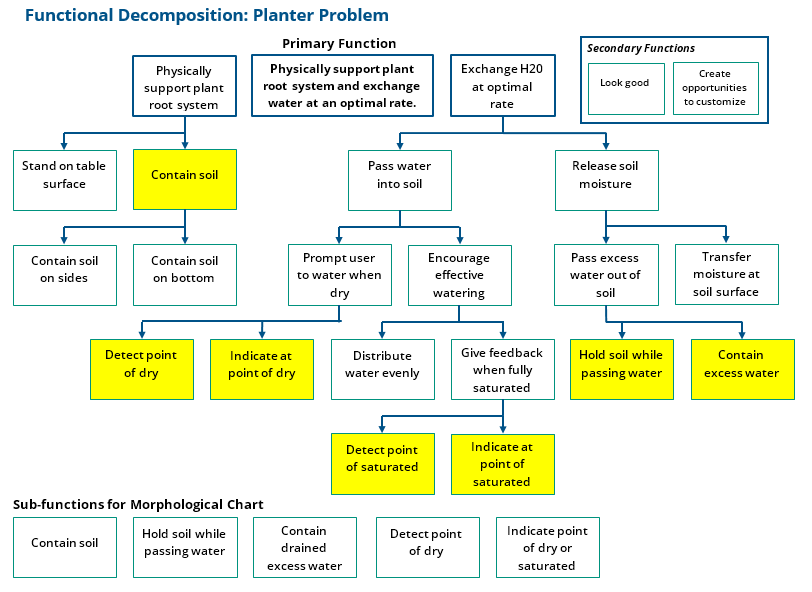
Now, select the most important and most basic sub-functions. Typically these will be the functions at the bottom of the tree. We will use these to generate creative mechanical design solutions.
Morphological Chart
Functional decomposition is the bones that support this product design process, but the morphological chart is the heart and soul. In the morphological chart you’ll generate concepts for each sub-function. You will generate concepts that you were not expecting. The trick is to generate concepts independently for each of your selected sub-functions. Each concept is written and roughly sketched in the morphological chart. You can spend 30 minutes generating concepts, or you can get a team together, use various techniques for concept generation, and spend a month. Either way, the process is the same, and it’s simple: make a chart with your functions at the top and ways to accomplish those functions below. Here’s a template as a pdf: Morphological Chart Template, and here’s my morphological chart:
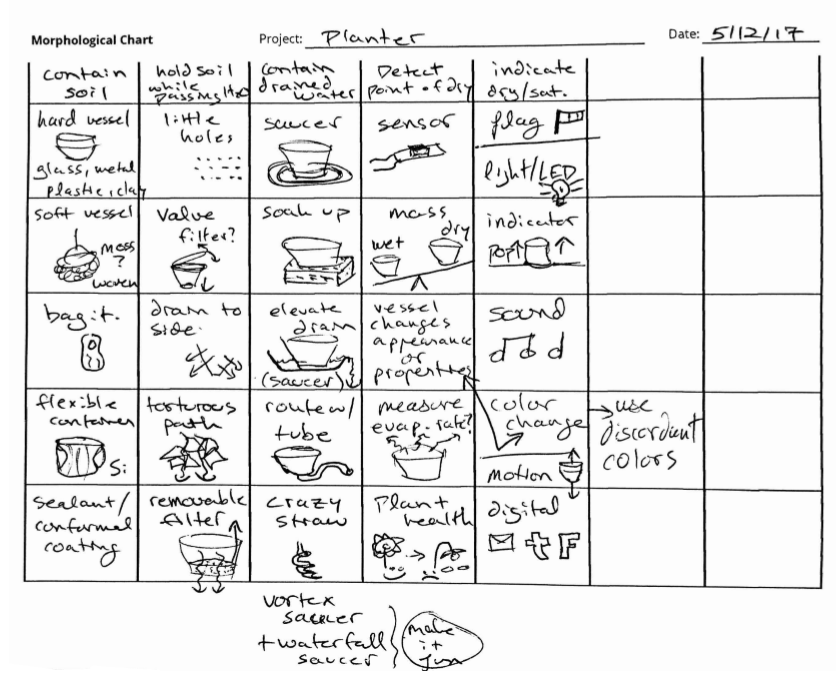 For each sub-function I generated a handful of concepts. This is the third chart I made, and I spent about an hour generating concepts.
For each sub-function I generated a handful of concepts. This is the third chart I made, and I spent about an hour generating concepts.
Now that we have all these concepts, it’s time to combine them to form several cohesive product design concepts. I usually aim to make three to five concepts out of my morphological chart. Here’s my chart of concepts:
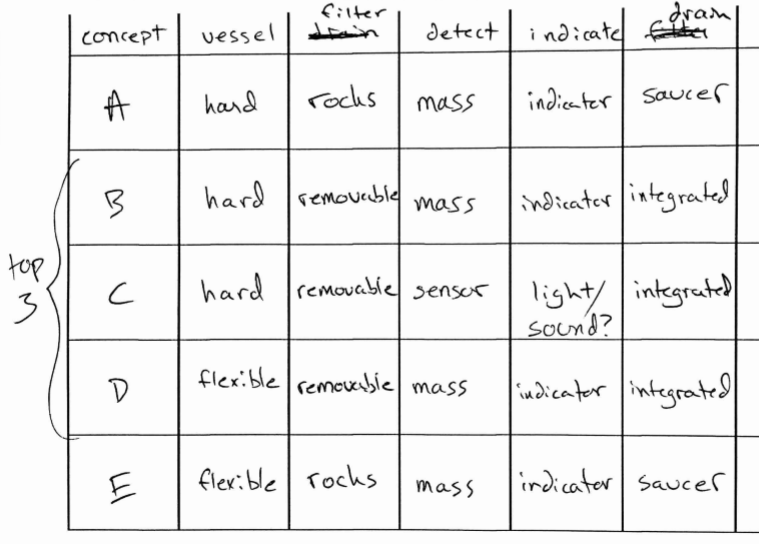
So we have these great concepts. All have pros and cons, and I have a sense of what I like, but I’d like to take my opinions out of the process as much as possible. To do this I use a points system to rank the concepts as they relate to the performance of the product.
First generate a list of questions that assess all aspects of the product’s performance. Included in this list should be feasibility. Feasibility can be yes/no, or it can be assessed in degrees from 1-5 (not feasible to certainly feasible). My questions are:
- Is the design feasible to prototype in 48 hours using the available equipment? yes/no/maybe
- How reliably does the concept signal appropriately? 0 – 5 (completely unreliable to 100% reliability)
- How easy is it for the user to not notice or ignore the signal? 0 – 5 (very easy to very hard)
- How easy is it to adjust the dryness trigger? 0 – 5 (difficult to easy)
- How easy is setup? 0 – 5 (difficult to easy)
- How well does the concept encourage proper watering technique? 0 – 5 (not at all to very well)
- How likely is it that the concept will break or need repair? 0 – 5 (sure thing to certainly never)
Now, let’s make just one more chart… Rank each concept A through E using the questions, above.
In this example, I calculated a straight sum of the values given for each concept. For some product design challenges I calculate a weighted sum — applying greater importance to certain attributes or risks.
We now have a straightforward ranking of our product concepts! If we cross-reference with feasibility, then we have our concept: Concept B.
We will design and prototype a planter consisting of a hard vessel using a removable filter (in place of rocks) and an integrated drain. The planter will use changes in mass to signal “time to water” with an indicator.
So…what’s that look like? In part 3 we will do a bit of ideation around what the planter could look like and how it could be put together. Then, and a little concurrently, we’ll head into CAD to design the planter, prototype it, and test. Go to Part 3.

